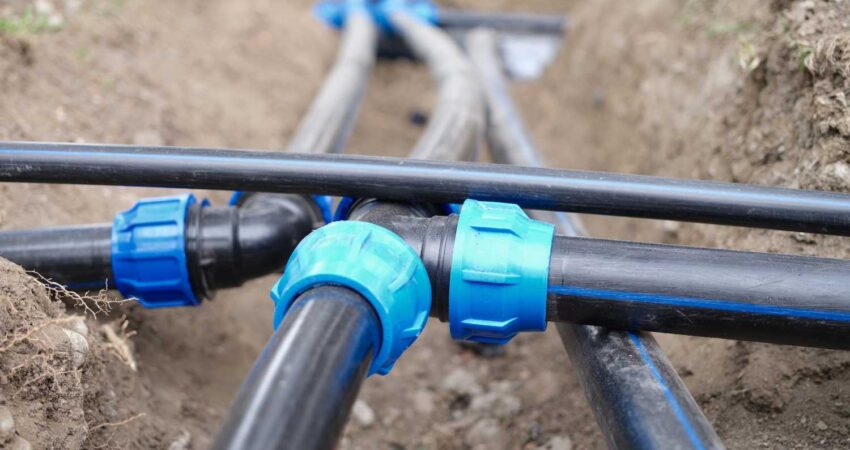Dallas is located where several rivers and creeks meet. To keep Dallas residents safe from flooding or erosion and for a sustainable living environment, a proper drainage system is indispensable.
It is important to understand the types of drainage systems. There are four main types of drain systems to help you choose according to the type and amount of water you need to drain, the type of soil, local regulations, and your budget.
Let’s dive into details to understand each of the drainage systems in detail.
What is a Drainage System?
A drainage system is a network of structures, piping, and channels. Drainage systems work to facilitate the removal of sewage, rainwater, or liquid wastes to the point of disposal, either in the sewer system or septic tank. It takes used water from plumbing fixtures and transports it to be removed safely.
Different Types of Drainage
Drainage is a network of various structures used to remove or redirect excess water from an area where it is not needed. If it remains in standing condition, it may lead to multiple issues like water logging, deterioration of your home’s exterior, erosion, and contamination.
To prevent such issues, there are four main types of drain systems, each of them designed for a specific purpose and environment.
Downspout and Gutters
Gutters and downspouts are a major component of a drainage system. They help you to manage rainwater and prevent water damage to your building.
Gutters
Gutters are part of a drainage system that is attached to the roof edges of a building. They collect rainwater from the roof and take it away from the building’s foundation, dropping into gutter drains. Gutter systems are generally made up of:
- Aluminum
- Vinyl
- Galvanized Steel
- Copper
- Galvalume
- Zinc
Downspout
Downspouts or drain pipes are vertical pipes that carry rainwater from gutters down to the ground level. It takes away excess water to prevent any potential damage to your home.
These house drainage systems can be made from various materials, including:
- Aluminum
- Vinyl
- Steel
- Copper
- PVC
Slope Drainage System
Slope drainage systems use gravity to flow away water from structures and sensitive areas in a downward direction. It helps to prevent soil erosion and landslides and prevent water damage to foundations, basements, and other structures. A well-designed and properly maintained slope drainage system is vital for the long-term stability and protection of your property on sloping terrain.
The materials used to slope drainage include:
- Plastic
- Concrete
- Steel
Surface Drainage System
Different from other drainage systems, it is a system of shallow ditches and channels that helps to remove water from the land surface. This type of drain system is suitable for soil with clay, subsoils, or slowly permeable soils. This system collects the water from an area and directs it to the main drain.
The surface drainage system is best for very flat land surfaces. Here are the key components of a surface drainage system:
- Open ditches, open drains
- Grassed waterways
- Berms and Ridging
- Swales
- Culverts
- Slope drains
- Permeable pavings
- Stormwater Inlets
- Catch Basins
- Drop Inlets
- Roadside gutter roof gutters
- Silt fences
Subsurface Drainage System
The residential subsurface drainage system runs underground. It consists of a network of pipes, tubes, conduits, or tiles that are installed under the ground surface to collect groundwater.
It is ideal for reducing mineral imbalance in the soil and plants. It also helps to reduce salinity and improves soil health.
These are the four main types of subsurface drainage systems.
- Corrugated and PVC slotted subsurface pipes
- Mole drainage
- Interceptor drains
- Groundwater pumps
Here is a video guide to help you understand the difference between the two types of drainage systems; surface drains and subsurface drains.
Wrap Up
It is important to manage the excess water around your home properly and to do this; you have to know the types of residential drainage systems that work together. By learning about these water drainage systems, you can make smart choices to keep your home safe from various water problems.
Go through this article to wisely invest in quality water drainage products like French drains, gutters, and downspouts, and outdoor drainage supplies like gravel-filled swales to protect your home from potential damage and add beauty while managing water runoff.
FAQs
What are the four types of drainage systems?
Four types of drainage systems include:
- Downspouts and gutters: Collect rainwater from your roof and transport it away from your building.
- Slope Drainage System: This system uses natural slopes to direct surface water runoff away from areas of flooding, preventing soil erosion and promoting efficient water flow.
- Surface Drainage System: Collects and channels the excess water underground surface to avoid water logging, erosion, and the formation of puddles.
- Subsurface Drainage System: It manages groundwater by utilizing pipes and drains buried below the surface to alleviate waterlogged areas.
Which type of drainage pattern is most commonly used?
Dendritic drainage systems are the most common type of drainage pattern. They can be used under a variety of geological conditions.
What are the four types of drainage patterns?
These are the types of drainage patterns:
- Dendritic
- Trellis
- Rectangular
- Radial
